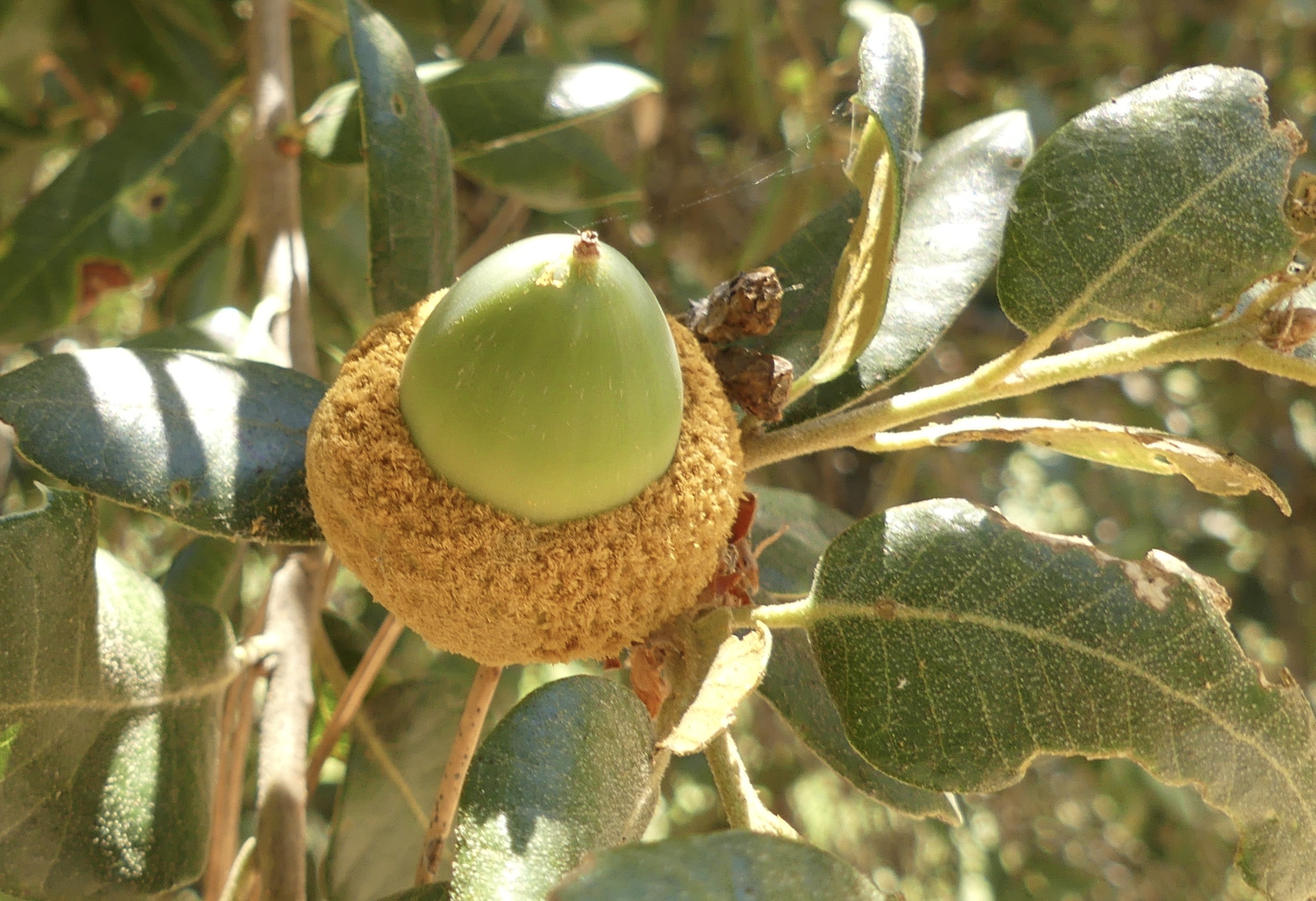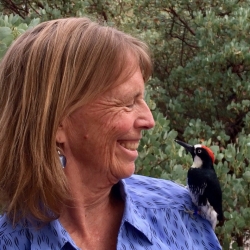Secrets Among the Oaks of the North Yuba Watershed
Dates: Aug 24-29, 2025
Instructor: Kate Marianchild
Fee: $600.00 + meals and accommodations fees
Term: Summer 2025
Workshop Description
During this class we will explore the oak, riparian, and meadow ecosystems of the spectacular Lakes Basin as well as downstream stretches of the North Yuba River. We will walk quietly with eyes and ears tuned for every movement and sound, stopping frequently to discuss the life cycles, behaviors, anatomy, and interrelationships of the flora, fauna, and fungi we will encounter.
On our oak-focused days, we will think about the evolutionary genius that enables oaks to support more organisms than any other plant genus in North America, and will identify oaks by their acorns, leaves, galls, and growth patterns. We will observe and discuss some of the myriad organisms that depend on oaks––from fungi, moths, and mistletoe to woodpeckers, woodrats, and bears.*
On other days, we will explore the lake, meadow, and stream habitats of the greater Lakes Basin area, learning about a wide range of plants and animals from silk tassel, manzanita, and aspen to antlions, mountain beavers, and American dippers.
When considering a plant species, we will wonder, “How is this plant pollinated?” “How are its seeds or spores dispersed?” “How many caterpillar species feed on it?” “How does it survive drought and fire?” “Does it partner with mycorrhizal fungi?” “Does it make all its sugars or is it parasitic?” The answers to some of these questions are mind-boggling!
When observing animal species, we will learn about metamorphosis, migration, and mimicry. We will ask, “What does this animal eat and who eats it?” “How does it hunt and where does it hide?” “Is it solitary or does it live in a social group?” “Does it reproduce underground, build a nest, or use a natural cavity?” “How and where does it overwinter?” “Is it engaged in co-evolutionary competition or cooperation with another animal or a plant?” And more…
In all the ecosystems we visit, we will use close-focus binoculars** to look at exquisitely magnified flowers, spiders, dragonflies, butterflies, and anything else that pauses long enough for us to focus on it. Birding binoculars will also come in handy for observing birds, squirrels, nests, and other distant phenomena. I usually wear both—close-up binoculars on a short strap and birding binoculars on a longer binocular harness.
We will generally walk less than two miles each day. We will venture off trail on uneven ground, so walking sticks would be helpful for those who use them. Once or twice, we will each settle into a “sit spot,” where we will watch and wonder as our eyes increasingly discern details and patterns in the world around us and the animals gradually resume their daily activities.
Participants who want to cover more ground will be free to hike vigorously during our free time on most afternoons.
*We probably won’t see woodrats or bears, but we will most likely see their houses and scat, respectively.


Instructor Bio
Kate Marianchild is the author of Secrets of the Oak Woodlands: Plants and Animals among California’s Oaks. In this nature writing classic, Kate weaves science, stories, and humor into portraits of twenty-two plant and animal species, portraying the unique behaviors and adaptations of each as well as their interrelationships. As a writer, presenter, and nature guide, Kate is known for her clear and riveting explanations, her fascination with her subject matter, and her contagious enthusiasm. Participants come away from her guided walks with “new eyes” for everything that flies, walks, swims, burrows, and blooms.
Kate has lived for twenty-three years in a 24-foot diameter wooden yurt outside of Ukiah amid the oak woodlands that inspired her book. In her spare time, she sings, swims, observes nature, makes acorn jewelry, and advocates for the preservation and restoration of oak woodlands.
Workshop Details
Workshop Schedule
We will meet briefly after dinner on Sunday, August 25, and will head out the next morning after breakfast. We’ll carpool to our trailhead, and on most days will return to campus by 3 or 3:30 pm. We will then have free time for hiking, swimming, resting, or whatever we choose, until dinner at 6. After dinner, we'll have a brief class with Q&A, show-and-tell, sharing nature lore, and at least one Powerpoint (probably about American dippers).
There may be one day when we return to campus at 5 pm and possibly skip the evening class.
Workshop Supplies List
Required
You can read about and/or purchase these items on my website or you may buy them from me on the first evening of our workshop. Please bring cash or check as internet will be sketchy or unavailable at the field station.
Close-focus binoculars, Papilio 8.5x21. $134 (This is the current price––I don’t know what the price will be in August of 2024). If purchasing these binoculars is a financial hardship, please try to borrow a pair. I don’t advise sharing a pair with another person as our chances to view animals like bees, butterflies, and birds are often fleeting.
Identifying the Common Oaks of Northern and Central California by Kate Marianchild. $7. (On my website, you must purchase a minimum of three, so if you don’t want extras to give as gifts, plan on purchasing one the first evening).
Secrets of the Oak Woodlands: Plants and Animals Among California’s Oaks by Kate Marianchild, currently in its 8th printing. $22.
Recommended
Birding binoculars (You’ll want a pair with a significantly wider field of vision than the 21 mm of the close-focus binoculars, such as 42 or 50 mm. Out of this World in Mendocino gives great advice over the phone about the pros and cons of different binoculars.)
Binocular harness I wear two pairs of binoculars at once. I keep my birding binoculars on a binocular harness, which takes the weight off my shoulders. I wear the much lighter close-focus binoculars on a short strap around my neck. Some people prefer to wear close-focus binoculars on their belts, in the case provided by the manufacturer.
Your favorite field guides (We’ll divvy our guides up so no one is carrying more than one book when we’re in the field. The rest will be handy back at the field station).
Walking sticks/trekking poles, if you use them.
Small notebook and writing or drawing implement(s), as desired.
Epipen if you need one.
Small containers for keeping “treasures” you collect from getting squished in your pack.
Lodging and Camping Supplies
Camping gear if you are staying on campus:
- tent and sleeping pad (unless you are staying in our tent with a cot provided)
- warm sleeping bag
- pillow, toiletries, and towel
- flashlight and lantern
- alarm clock
Field gear for everyone:
- day pack
- sunscreen
- insect repellant
- water bottles
- plastic containers for packed lunches
- sense of humor
You might also want to bring:
- camera
- binoculars
- hand lens
- camp chair
Clothing:
The weather in the Sierra Nevada can vary greatly, even in a single day. Be prepared for chilly temperatures at night, even below freezing early in the summer. Rain is a possibility any time, whether forecast or not. Variable weather clothing that can be layered is best: long pants and a long-sleeved shirt, warm sweater and jacket, t-shirt and shorts or skirt, sturdy shoes or hiking boots, sun hat, rain gear, and a warm hat or gloves for cold weather and/or night activities. And, if you come later in the season, bring your swimsuit for afternoon dips in the lakes!